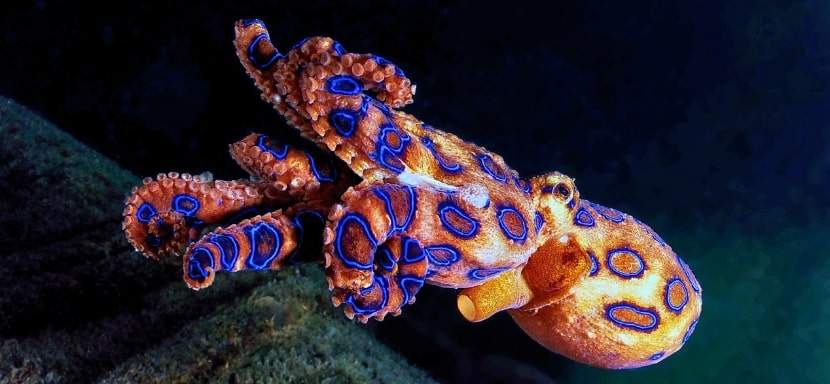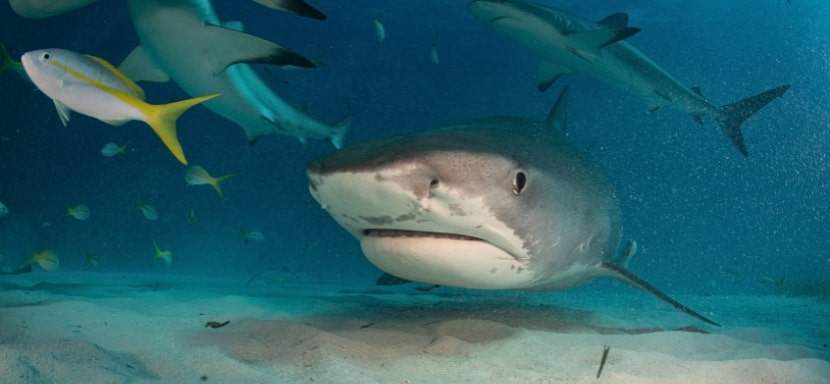How to Survive Deadly Sea Creatures

Survive Deadly Sea Creatures, Ocean Safety Tips
Sharks are not the only creatures in the sea; jellyfish and stingrays are swimmers that can become very aggressive if threatened or provoked.
Many sea creatures can turn your leisurely afternoon swim into a survival situation. Be careful where you venture into the sea.
However, sharks who attack people get most of the attention. Several sea creatures can give you an awful sting, bite, or even be fatal.
Navigating the Depths with Knowledge and Caution
The ocean, with its vast expanses and mysterious depths, is home to many creatures. While many of these beings are harmless, there exists a select group whose reputation for danger precedes them.
Learning to survive deadly sea creatures is not just about ensuring your safety; it’s about fostering a respectful coexistence with nature’s marvels. In this comprehensive guide, we will explore practical tips and insights for minimizing risks while enjoying the ocean’s wonders.
This article is your go-to resource for ocean safety, from understanding shark behaviors to knowing what to do in the unlikely event of a jellyfish sting.
How to Survive Deadly Sea Creatures: A Deep Dive into Safety and Awareness
Discover key safety tips and awareness strategies for safely navigating encounters with the ocean’s formidable inhabitants.
This guide highlights the importance of recognizing potential dangers, offers insights into the behaviors of creatures like sharks, jellyfish, and stingrays, and suggests proactive measures to minimize the risk of adverse interactions.
Learn effective response tactics for unexpected encounters, receive crucial first aid instructions for marine-related injuries, and understand the significance of marine conservation and respect.
Understanding Your Aquatic Neighbors
Navigating the ocean’s beauty comes with risks, from the misunderstood to the unmistakably perilous. Understanding these creatures enhances our safety and respect for their roles in the marine ecosystem.
Did You Know?
An encounter with a stingray’s barbed tail is not ordinarily fatal unless it punctures a vital area on the body. However, the sting can be excruciating and be accompanied by a lot of swelling.
The Anatomy of Risk: Identifying Potential Threats
While awe-inspiring, venturing into the ocean’s embrace brings inherent risks from the diverse array of creatures that call it home. Awareness of potential dangers is not just advisable; it’s indispensable for anyone looking to navigate these waters safely. The key to minimizing risk is understanding which sea creatures could pose threats and under what conditions interactions may become perilous.
Each marine species has its behaviors, habitats, and defense mechanisms. For example, while formidable predators, many sharks generally do not consider humans prey. However, certain activities, such as spearfishing, can increase the risk of a shark mistaking a human for a rival predator or as part of its natural food chain. Recognizing behaviors that may provoke or attract dangerous sea creatures is crucial in avoiding potentially hazardous encounters.
Similarly, the beauty of a jellyfish’s drift through the water belies its potential danger. Jellyfish stings can range from mildly irritating to severely painful and, in rare cases, life-threatening. Understanding the conditions that lead to increased jellyfish presence, such as warmer waters or seasonal blooms, can help swimmers and divers take preventive measures, such as wearing protective clothing or choosing not to enter the water during peak jellyfish season.
Another aspect of identifying potential threats involves recognizing environmental conditions that may increase the likelihood of encountering dangerous sea life. For instance, swimming near river mouths or in areas with known rip currents exposes one to powerful water movements. It can increase encounters with predatory animals attracted to these areas by smaller prey.
In addition, the ocean floor can harbor hazards, from sharp coral that can inflict severe cuts to camouflaged creatures like stingrays and stonefish. Learning to navigate these environments carefully, such as avoiding touching or standing on the seabed in unfamiliar areas, can prevent painful or venomous injuries.
Educating oneself about the marine environment and its inhabitants, paying attention to local warnings and advisories, and adopting a cautious and respectful approach to interacting with the ocean are all fundamental to identifying and mitigating risks. By doing so, individuals can enjoy the vast beauty and thrill of the sea while ensuring their adventures remain as safe as possible, marking the true essence of understanding the anatomy of risk in the marine world.

Preventative Measures: Reducing the Risk of Encounters
Diving into the ocean is like stepping into a different world filled with beauty, mystery, and some potential risks. But don’t let that deter you from exploring the deep blue. With the proper knowledge and precautions, you can significantly reduce the likelihood of unwanted encounters with its more dangerous residents.
Here’s how you can equip yourself for safer ocean adventures:
The Power of Knowledge: Research and Preparation
- Understand Local Marine Life: Before you go, research the types of sea creatures you might encounter. Some might be harmless, while others may not be.
- Stay Informed About Sightings: Check local news or online forums for recent sightings of dangerous sea creatures in your intended area of exploration.
- Learn Emergency Procedures: Knowing what to do in the rare case of an encounter can make all the difference.
Safe Swimming Practices: Timing, Locations, and Behavior
- Choose Your Timing Wisely: Some sea creatures are more active at dawn and dusk. Swimming during midday can sometimes be safer.
- Select Your Location Carefully. Avoid areas known for dangerous marine life. Swim continuously in areas monitored by lifeguards.
- Mind Your Behavior: Avoid erratic movements or swimming alone. Stay calm and composed, as panicked movements can attract unwanted attention.
Equipment Essentials: Protective Gear for Ocean Adventures
- Wear Protective Clothing: A wetsuit or dive skin can provide a barrier against stings and bites.
- Carry a Safety Kit: Include items like vinegar for jellyfish stings, a first aid kit, and a waterproof phone case for emergencies.
- Use Anti-Shark Devices if Necessary: Technologies like shark deterrent bands can offer peace of mind in shark-prone areas.
The Buddy System: Safety in Numbers
- Never Swim Alone: Always have a buddy with you. It’s safer and more fun.
- Monitor Each Other: Regularly check your buddy’s whereabouts and well-being.
- Plan Your Dive or Swim: Agree on a plan for encountering potentially dangerous creatures.
In the Moment: Responding to Encounters with Deadly Sea Creatures
When you’re out there in the big blue, feeling like part of the vast oceanic tapestry, it’s crucial to remember that you’re in the realm of some of nature’s most awe-inspiring creatures. While encounters with dangerous sea creatures are rare, knowing how to react can make all the difference.
Here’s your guide to staying safe should you find yourself face-to-fin with the ocean’s more formidable inhabitants:
Shark Encounters: Staying Calm and Assertive
- Stay Calm: Avoid panic. Sharks sense fear and confusion.
- Maintain Eye Contact: Keep the shark in your field of vision.
- Back Away Slowly: Do not turn your back. Move steadily towards safety without sudden movements.
Jellyfish Stings: Immediate Actions and Remedies
- Don’t Rub the Sting: Rubbing can cause more venom to be released.
- Rinse with Vinegar or Seawater, not Freshwater: This can neutralize some venom types.
- Seek Medical Help for Severe Reactions: Some stings can cause serious health issues.
Stingray Wounds: Steps to Mitigate the Harm
- Immerse the Wound in Hot Water: This can help neutralize the venom and reduce pain.
- Do Not Remove any Barbs Yourself: Seek professional medical treatment immediately.
- Apply Pressure if Bleeding: Avoid tight bandages directly on the wound.
Blue-Ringed Octopus: Immediate Response
- Do Not Touch: Their bite can be painless, but the venom is potent.
- Get Out of the Water: To prevent drowning if paralysis sets in.
- Seek Emergency Medical Attention Immediately: There’s no antidote, but supportive care is crucial.
Sea Wasp (Box Jellyfish) Stings: Urgent Care
- Rinse With Vinegar: This can deactivate the stingers and stop releasing more venom.
- Do Not Apply Pressure Bandages: This can cause more venom to be released.
- Seek Medical Attention Promptly: Antivenom is available for box jellyfish stings.
Rip Currents: Strategies for Safe Escape
- Don’t Fight the Current: Swim parallel to the shore until you’re out of the current.
- Stay Afloat and Signal for Help: If you can’t swim to the shore, conserve energy and draw attention.
First Aid and Medical Response
When exploring the vast and beautiful ocean, being prepared for the unexpected is not just bright—it’s essential. Despite our best efforts to prevent them, encounters with dangerous sea creatures can happen. Knowing how to respond with adequate first aid can significantly affect the outcome of such encounters.
Let’s get you prepped and ready:
First Aid for Marine Animal Injuries: A Primer
- Stay Calm and Get to Safety: First and foremost, calmly remove yourself or the injured person from the water to prevent further harm.
- For Jellyfish stings: Rinse the affected area with vinegar to neutralize the sting. Do not rub the area, as this can aggravate the stingers.
- For Stingray Wounds or Fish Spines: Immerse the wound in hot water (as hot as tolerated) for 30 to 90 minutes to reduce pain and inactivate toxins.
- For Shark Bites or serious wounds: Apply pressure to stop the bleeding, cover the wound with a sterile bandage, and immobilize the injured body part.
- For Blue-Ringed Octopus and Sea Wasp (Box Jellyfish) Stings: These are medical emergencies. Apply vinegar to the sting site for box jellyfish. Do not apply pressure bandages. For blue-ringed octopus bites, apply pressure immobilization technique and seek immediate medical attention due to the risk of paralysis.
When to Seek Medical Attention: Recognizing Severity
- Difficulty Breathing, Chest Pain, or Severe Pain: These symptoms indicate a severe reaction that requires immediate medical attention.
- Signs of Infection: If the wound becomes red, swollen, or pus-filled, it’s time to see a doctor.
- Tetanus Risk: Deep or dirty wounds may require a tetanus shot if you haven’t had one in the past five years.
The Role of Lifeguards and Emergency Services
- Alert a Lifeguard Immediately: If you’re at a lifeguard-patrolled beach, immediately inform them of the situation. They are trained to handle such emergencies, provide first aid, and call for further medical assistance.
- Use Emergency Services if Needed: Don’t hesitate to call for an ambulance if the situation seems severe. It’s better to be safe and ensure professional medical care is coming.
The Cone Snail
With its attractive shell, it is one of the ocean’s most deadly creatures. Its venom, delivered through a harpoon-like tooth, can immobilize fish instantly and is potent enough to kill a human, making it a small but formidable predator.
Conservation and Respect: The Ethical Approach to Marine Life
The ocean is not just a playground for adventure and discovery but also a delicate ecosystem that requires our understanding, respect, and active conservation. Each creature, from the majestic whale to the microscopic plankton, plays a vital role in the marine ecosystem, contributing to the ocean’s health and, by extension, our planet’s well-being. As we navigate the waters, adopting an ethical approach towards marine life is crucial, as is understanding our impact and how we can contribute to its preservation.
Understanding the Role of Sea Creatures in the Ecosystem
- No matter how small or seemingly insignificant, every sea creature has a role in the marine food web. Predators like sharks maintain the health of fish populations by removing the sick and weak, while creatures such as coral and oysters filter the water, improving its quality.
- The diversity of marine life also contributes to genetic and ecosystem resilience, helping the ocean adapt to changes and recover from disturbances.
Human Impact: Pollution, Climate Change, and Habitat Destruction
- Our actions on land have far-reaching effects on the ocean’s health. Pollution, such as plastic waste, chemicals, and oil spills, directly threatens marine life and often leads to injury, illness, or death.
- Climate change, driven by greenhouse gas emissions, is causing ocean temperatures to rise and acidification levels to increase, resulting in coral bleaching and disrupting marine habitats.
- Overfishing and habitat destruction due to coastal development and activities like bottom trawling devastate marine ecosystems, leading to the loss of biodiversity and ecosystem services.
Advocacy and Action: Participating in Ocean Conservation
- Educate yourself and others about the importance of the ocean and the challenges it faces. Knowledge is the first step toward change.
- Support and participate in local and global conservation efforts. This can range from joining beach clean-ups to supporting organizations working towards ocean conservation.
- Advocate for policies and practices that protect marine environments. Use your voice to support sustainable fishing, marine protected areas, and regulations that reduce pollution.
- Make environmentally conscious choices in your daily life. Reduce your use of single-use plastics, opt for sustainable seafood, and lower your carbon footprint.

Beyond Survival: Fostering a Positive Relationship with the Ocean
Building a positive relationship with the ocean goes beyond avoiding its dangers; it involves respecting and understanding its vast ecosystem. By educating ourselves about marine life and environmental challenges, we can make informed decisions that promote ocean health. This education can come from documentaries, books, or even aquarium visits, which all help deepen our appreciation for the ocean’s complexity.
Choosing eco-friendly activities is another way to show our respect for the ocean. Opting for non-invasive recreational activities like kayaking, paddleboarding, or sailing allows us to explore without harming marine habitats. Sustainable tourism practices also play a crucial role in protecting marine environments.
Spreading awareness about ocean safety and conservation can inspire others to adopt more sustainable behaviors. Sharing knowledge through social media, community forums, or personal networks raises awareness about the importance of protecting marine life. Participating in community conservation efforts, such as beach clean-ups, not only contributes to the health of marine ecosystems but also fosters a community spirit focused on ocean preservation.
In summary, fostering a positive relationship with the ocean means educating ourselves, engaging in sustainable activities, and spreading the word about conservation. By taking these steps, we contribute to a future where humans and the ocean thrive together.
Conclusion: Embracing the Ocean with Preparedness and Respect
In exploring how to survive deadly sea creatures, we’ve sparked a deeper discussion about our connection with the ocean. This journey emphasizes that knowledge and respect are our best tools for navigating these waters safely, promoting our well-being and marine life conservation. This guide aims to serve as a navigational tool in the vast, blue expanse, leading you towards exhilarating adventures while keeping you mindful of our environmental responsibilities.
It’s designed to be more than a mere survival manual; it’s intended to enlighten and guide us toward responsible and enriching interactions with the ocean. By understanding the dangers of particular sea creatures and adopting safety measures, we embrace a broader role as stewards of the marine ecosystem. Our approach to the ocean shouldn’t be dominated by fear but informed by profound respect and a desire to protect its diversity.
As we adopt preparedness and respect in our oceanic adventures, we open the door to thrilling experiences yet conscious of the ecological balance essential for marine life. Our choices, from participating in eco-friendly ocean activities to supporting marine conservation efforts, have the power to impact this delicate ecosystem positively.
Let this guide act as your compass, steering you through the ocean’s wonders in a way that celebrates its beauty and mystery while acknowledging our duty to safeguard it. By fostering a relationship with the sea based on mutual respect, we ensure a future where both humans and marine life can flourish, protected by our concerted conservation efforts.
Deadly Sea Creature Survival Stories in History
Survivor stories involving encounters with sea creatures have fascinated people for centuries, offering dramatic tales of human resilience, bravery, and, sometimes, sheer luck.
Here are a few of the most remarkable sea creature survivor stories from history:
- Bethany Hamilton (2003): Bethany Hamilton became a source of inspiration worldwide after surviving a shark attack at 13. While surfing off Kauai’s North Shore, she lost her left arm to a 14-foot tiger shark. Not only did she survive, but she also returned to professional surfing and has since won numerous titles.
- The Essex Whaling Ship (1820): The story of the Essex inspired Herman Melville’s “Moby-Dick.” In 1820, a sperm whale, reportedly 85 feet long, rammed and sank the Essex in the South Pacific Ocean. The crewmembers who survived the sinking faced harrowing conditions at sea, resorting to cannibalism before the final eight survivors were rescued more than 90 days later.
- Mike Spalding (2010): In a rare case of survival, Mike Spalding was bitten by a cookie-cutter shark while swimming across the Alenuihaha Channel between the Big Island and Maui in Hawaii. Despite the unusual and severe bite, Spalding continued swimming and reached the shore with his support team’s help.
- Henri Bource (1964): Henri Bource, a cinematographer and diver, was filming underwater near Lady Julia Percy Island, Australia when he was attacked by a great white shark, which severed his leg. Bource survived the attack and continued his career in underwater cinematography and shark conservation.

More Wild Frontier Scenarios
How to Survive a Mountain Lion Attack
Learn how to survive a mountain lion attack with practical steps to protect yourself and stay safe in. Surviving a…
How to Survive a Raccoon Attack
It’s a quiet evening, the moon is out, and maybe you’re taking out the trash or just enjoying a night…
How to Survive a Wild Boar Attack
Encountering a wild boar is like meeting your ex at a grocery store—unexpected, unnerving, and, in most…
How to Survive a Swarm of Bees
Surviving a bee swarm might sound like a scene out of a movie, but it’s a real concern for those who…
How to Survive a Skunk Spray
Getting sprayed by a skunk is a smelly situation that no one wants to find themselves in. However, if…
Recent Survival Posts
How to Survive a Layoff
Layoffs feel personal—even when they’re not. One day, you’re responding to Slack messages and forwarding…
How to Survive a Drug Test
I never imagined I’d be so emotionally invested in a paper cup. But there I was, standing under the fluorescent…
How to Survive an Interrogation
If you’ve ever been caught in the crosshairs of an overly enthusiastic mall cop or stared down by someone…
How to Survive a Nightclub Shooting
Nightclubs pulse with life—lights flashing, music pounding, bodies packed tight on the dance floor. It’s a place to…
How to Survive a Bachelor Party
A bachelor party is a delicate mix of celebration, chaos, and questionable decision-making, wrapped…
More Wild Frontier Survival Scenarios

How to Survive a Raccoon Attack
It’s a quiet evening, the moon is out, and maybe you're taking out the trash or enjoying a night on your porch. And suddenly, out of the shadows, bam! There it is—those black-ringed eyes glowing at you like some creature from a raccoon version of “The Shining.” If...

How to Survive a Wild Boar Attack
Encountering a wild boar is like meeting your ex at a grocery store—unexpected, unnerving, and, in most cases, best avoided. Yet, wild boars aren't interested in your baggage or drama; they're just trying to mind their own business—unless they think you're a threat....

How to Survive a Swarm of Bees
Surviving a bee swarm might sound like a scene out of a movie, but it's a genuine concern for those who love the outdoors. Imagine this: you're hiking on a beautiful sunny day, enjoying the tranquility of nature, when suddenly you hear a low buzzing sound that...

How to Survive a Skunk Spray
Getting sprayed by a skunk is a smelly situation that no one wants to find themselves in. However, if you do end up as a target of this defensive mechanism, knowing how to handle the aftermath can make a huge difference. Let's explore some practical steps and advice...

How to Survive a Bear Attack
Bear Attack Survival Tips and Strategies Though rare, bear attacks can occur because bears remember food locations for years and may silently track humans to assess threats or follow scents. Surviving a bear attack involves more than just reacting during an encounter;...
More Survival Scenarios

How to Survive a Layoff
When the Floor Falls Out: The Reality of a Layoff Layoffs feel personal—even when they're not. One day, you're responding to Slack messages and forwarding emails. Next, you're staring at your monitor as it logs you out... for good. Whether it's a restructuring, a...

How to Survive a Drug Test
The Cup, The Room, The Truth I never imagined I’d be so emotionally invested in a paper cup. But there I was, standing under the fluorescent hum of a strip-mall clinic, trying to recall the last time I ate a poppy seed bagel. That’s the thing about drug tests—they...

How to Survive an Interrogation
If you've ever been caught in the crosshairs of an overly enthusiastic mall cop or stared down by someone in a uniform with a clipboard and a glare, you’ve felt it — the chilly fingers of interrogation anxiety. And while most of us imagine interrogation scenes as...

How to Survive a Nightclub Shooting
Nightclubs pulse with life—lights flashing, music pounding, bodies packed tight on the dance floor. It’s a place to escape, feel the rhythm, and lose yourself in the crowd. But that same energy can turn deadly in seconds, transforming a night of fun into one of the...

How to Survive a Bachelor Party
A bachelor party is a delicate mix of celebration, chaos, and questionable decision-making, wrapped in the noble intention of sending the groom off into married life with a night he’ll (hopefully) remember. It’s a ritual as old as time—well, as old as men deciding...

How to Survive Your First Time at the Gym
Walking into a gym for the first time can feel like stepping into an alien world. The machines hum with purpose, the regulars move confidently, and you’re left standing there, clutching your water bottle, wondering whether you’re in the right place—or on the right...

How to Survive a Worldwide Communications Breakdown
Imagine waking up to silence. Your phone doesn’t buzz, your email won’t load, and even your local radio station crackles with static. A worldwide communications breakdown has hit. What next? For many, this doomsday scenario may sound like the opening lines of a...

How to Survive a Flash Flood While Driving
Surviving a flash flood while driving requires quick thinking, calmness, and a solid plan to ensure your safety. Preparation can make all the difference between a close call and a catastrophe in emergencies like this. This guide provides practical advice to protect...

How to Build an Emergency Kit
Emergencies don’t knock politely at the door. They barge in, uninvited, like a distant relative with a penchant for drama, turning your world upside down without warning. Whether it’s a power outage, a natural disaster, or an unexpected evacuation, the key to staying...

How to Protect Yourself From Insects in the Wild
There’s nothing like being out in the wild—birdsong echoing through the trees, the fresh scent of earth, and a deep sense of peace that makes you think, “Ah, this is what life is about.” But then comes the buzzing. Mosquitoes, ticks, and flies swoop in like uninvited...
